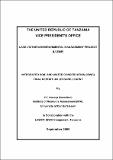| dc.description.abstract | Introduction The Lake Victoria Basin represents a good scenario of environmental problems related to human activities on land. Land degradation in the lake basin is of major concern, not only for the healthy of the lake, but also for food and livelihood security of its rapidly expanding population. The multiple livelihood activities undertaken by local communities have contributed to degradation of the lake environment. Soil erosion is evident in many parts of the lake basin, exacerbated by poor land and water management. These environmental concerns are among the issues that are addressed by the Lake Victoria Environmental Management Project (LVEMP). About this Consultancy Tanzania has been implementing the Lake Victoria Environmental Management Project (LVEMP) in the lake basin since 1997/98. The fundamental objective of the Project is to restore a healthy, varied lake ecosystem that is inherently stable and can support, in a sustainable way, the many human activities in the catchment and in the lake itself. In order to achieve its objectives ten components were established and implemented under LVEMP, one being the Integrated Soil and Water Conservation (ISWC). Implementation of the ISWC project activities in the pilot areas during Phase One was however, achieved with varying degrees of success and encountered various challenges. Before expanding the component activities to cover the whole of Lake Victoria basin, these strengths, weaknesses and gaps need to be identified. The objective of this consultancy was therefore to prepare a Lessons Learnt Report in relation to the Integrated Soil and Water Conservation activities.
The Integrated Soil and Water Conservation The overall objective of this component was to improve land use management of the lake catchment for sustainable utilization of Lake Victoria Basin resources. The implementation of activities during Phase One under the ISWC component focused on selected pilot areas. The pilot areas for ISWC are located in Simiyu River Catchment in Magu District and Mwitore Catchment in Tarime District. The ISWC component has two sub-programmes namely Soil and Water Conservation and Agro-chemicals Management. The consultancy focused on the Soil and Water Conservation sub-programme. The Agro-chemicals Management sub-programme was addressed under Water Quality Management for production of Synthesis Report. Methodology A variety of approaches and methods were employed in order to address the issues outlined in the Terms of Reference. These included literature review, field visits, and interviews with key informants and villagers. Most of the activities were done in collaboration with ISWC component staff. Interview data collected from farmers were coded and tabulated. The tabulated responses were then analysed using frequencies, ranges and percentages of respondents that reported a particular concern. Further analysis was done using Excel Software to calculate averages, for example of crop yields. The various responses from interviews were then integrated with information obtained from the documented data sources (e.g. of various project document) together with information obtained from the consulted institutions. | en_US |

